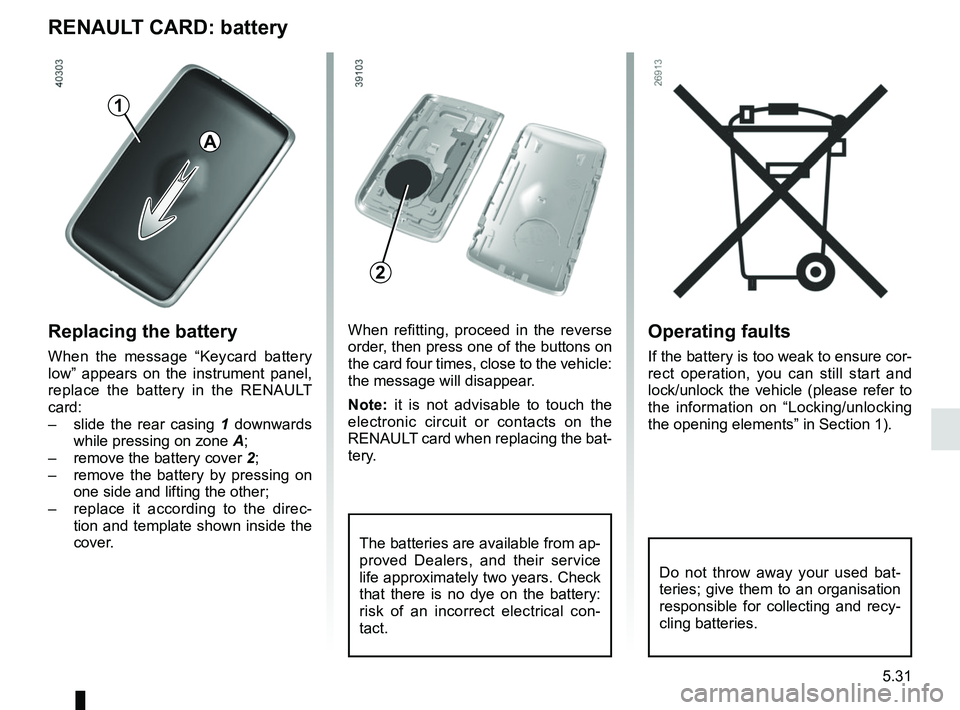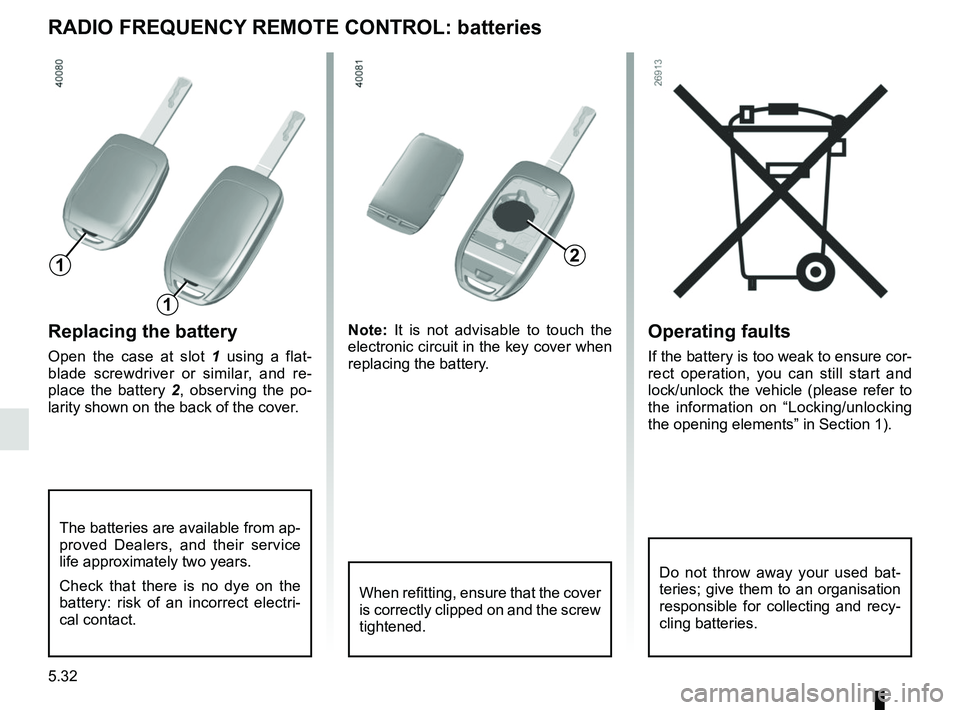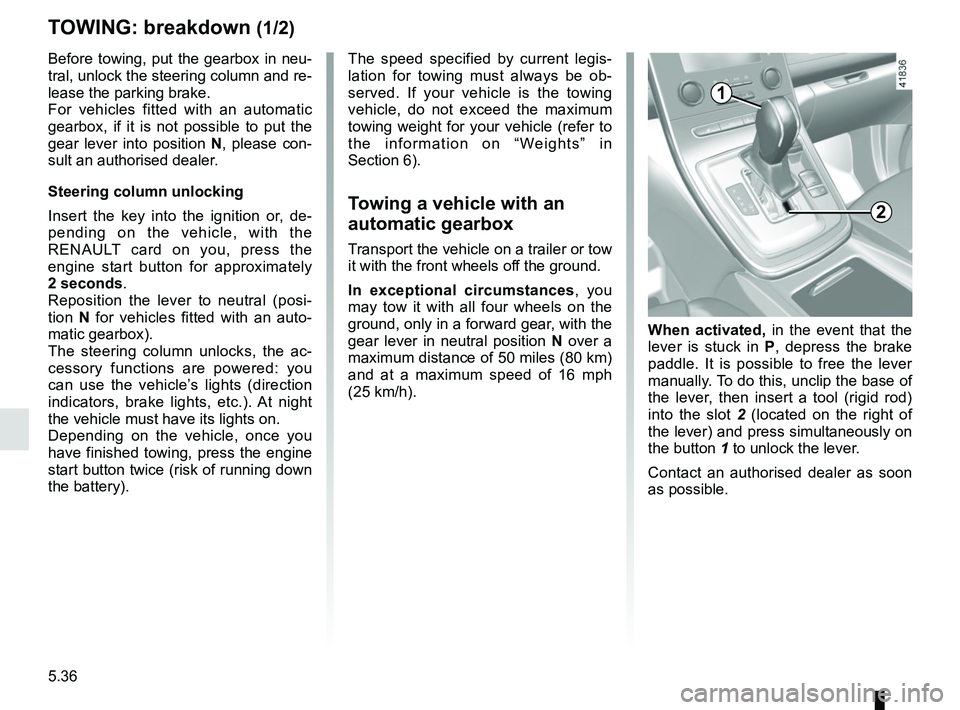2018 RENAULT SCENIC battery
[x] Cancel search: batteryPage 322 of 364

5.30
Starting the vehicle using the
battery from another vehicle
If you have to use the battery from an-
other vehicle to start, obtain suitable
jump leads (with a large cross section)
from an approved dealer or, if you al-
ready have jump leads, ensure that
they are in perfect condition.
The two batteries must have an iden-
tical nominal voltage of 12 volts. The
battery supplying the current should
have a capacity (amp-hours, Ah) which
is at least the same as that of the dis-
charged battery.
Ensure that there is no risk of contact
between the two vehicles (risk of short
circuiting when the positive terminals
are connected) and that the discharged
battery is properly connected. Switch
off your vehicle ignition.
Start the engine of the vehicle supply-
ing the current and run it at a moderate
speed.
12 VOLT BATTERY: troubleshooting (2/2)
3
B
A
1
Lift the red cover on box 1 located
behind the battery.
Connect the positive cable A to sup-
port 3 (+) located under the box
cover 1, then to terminal 5 (+) of the
battery supplying the current.
Connect the negative cable B to the
terminal 4 ( – ) of the battery supply-
ing the current then to the metal cable 2
( – ) of the discharged battery.
Start the engine, and as soon as it starts
running, disconnect cables A and B in
reverse order ( 2 - 4 - 5 - 3).
2
54
2
Check that there is no con-
tact between leads A and B
and that the positive lead A
is not touching any metal
parts on the vehicle supplying the
current.
Risk of injury and/or damage to
the vehicle.
23
Page 323 of 364

5.31
Operating faults
If the battery is too weak to ensure cor-
rect operation, you can still start and
lock/unlock the vehicle (please refer to
the information on “Locking/unlocking
the opening elements” in Section 1).
RENAULT CARD: battery
Replacing the battery
When the message “Keycard battery
low” appears on the instrument panel,
replace the battery in the RENAULT
card:
– slide the rear casing 1 downwards
while pressing on zone A;
– remove the battery cover 2;
– remove the battery by pressing on
one side and lifting the other;
– replace it according to the direc-
tion and template shown inside the
cover.
When refitting, proceed in the reverse
order, then press one of the buttons on
the card four times, close to the vehicle:
the message will disappear.
Note: it is not advisable to touch the
electronic circuit or contacts on the
RENAULT card when replacing the bat-
tery.
The batteries are available from ap-
proved Dealers, and their service
life approximately two years. Check
that there is no dye on the battery:
risk of an incorrect electrical con-
tact.
2
A
1
Do not throw away your used bat-
teries; give them to an organisation
responsible for collecting and recy-
cling batteries.
Page 324 of 364

5.32
Operating faults
If the battery is too weak to ensure cor-
rect operation, you can still start and
lock/unlock the vehicle (please refer to
the information on “Locking/unlocking
the opening elements” in Section 1).
Replacing the battery
Open the case at slot 1 using a flat-
blade screwdriver or similar, and re-
place the battery 2 , observing the po-
larity shown on the back of the cover. Note:
It is not advisable to touch the
electronic circuit in the key cover when
replacing the battery.
RADIO FREQUENCY REMOTE CONTROL: batteries
When refitting, ensure that the cover
is correctly clipped on and the screw
tightened.
The batteries are available from ap-
proved Dealers, and their service
life approximately two years.
Check that there is no dye on the
battery: risk of an incorrect electri-
cal contact.
2
1
1
Do not throw away your used bat-
teries; give them to an organisation
responsible for collecting and recy-
cling batteries.
Page 328 of 364

5.36
TOWING: breakdown (1/2)
Before towing, put the gearbox in neu-
tral, unlock the steering column and re-
lease the parking brake.
For vehicles fitted with an automatic
gearbox, if it is not possible to put the
gear lever into position N, please con-
sult an authorised dealer.
Steering column unlocking
Insert the key into the ignition or, de-
pending on the vehicle, with the
RENAULT card on you, press the
engine start button for approximately
2 seconds.
Reposition the lever to neutral (posi-
tion N for vehicles fitted with an auto-
matic gearbox).
The steering column unlocks, the ac-
cessory functions are powered: you
can use the vehicle’s lights (direction
indicators, brake lights, etc.). At night
the vehicle must have its lights on.
Depending on the vehicle, once you
have finished towing, press the engine
start button twice (risk of running down
the battery). The speed specified by current legis-
lation for towing must always be ob-
served. If your vehicle is the towing
vehicle, do not exceed the maximum
towing weight for your vehicle (refer to
the information on “Weights” in
Section 6).
Towing a vehicle with an
automatic gearbox
Transport the vehicle on a trailer or tow
it with the front wheels off the ground.
In exceptional circumstances
, you
may tow it with all four wheels on the
ground, only in a forward gear, with the
gear lever in neutral position N over a
maximum distance of 50 miles (80 km)
and at a maximum speed of 16 mph
(25 km/h).
When activated, in the event that the
lever is stuck in P , depress the brake
paddle. It is possible to free the lever
manually. To do this, unclip the base of
the lever, then insert a tool (rigid rod)
into the slot 2 (located on the right of
the lever) and press simultaneously on
the button 1 to unlock the lever.
Contact an authorised dealer as soon
as possible.
2
1
Page 330 of 364

5.38
OPERATING FAULTS (1/7)
Using the RENAULT cardPOSSIBLE CAUSES WHAT TO DO
The RENAULT card does not lock or
unlock the doors. Card battery is flat.
Replace the battery. You can still lock/
unlock and start your vehicle (refer to the
information on “Locking/unlocking the
doors” in Section 1 and “Starting/Stopping
the engine” in Section 2).
Use of appliances operating on the
same frequency as the card (mobile
phone, etc.). Stop using the equipment or use the in-
tegrated key (refer to the information on
“Locking, unlocking the opening elements”
in Section 1).
Vehicle located in a high electromag-
netic radiation zone.
Vehicle battery flat. Use the key integrated in the card (refer to
the information on “Locking, unlocking the
opening elements” in Section 1).
The message “Place card close to
START button” appears on the instru-
ment panel. Hold the start button card close until the
instrument panel message stops being dis-
played, then press the same button within
2 seconds of the message going out.
The vehicle is started. With the engine running, the card’s locking/
unlocking device is blocked. Turn off the ig-
nition.
Page 331 of 364

5.39
The following advice will enable you to carry out quick, temporary repai\
rs. For safety reasons you should always contact
an approved dealer as soon as possible.
Using the remote controlPOSSIBLE CAUSES ACTION REQUIRED
The remote control does not lock or
unlock the doors. The remote control battery is flat.
Use the emergency key.
Use of appliances operating on the same
frequency as the remote control (mobile
phone, etc.). Stop using the devices or use the key.
Vehicle located in a high electromagnetic
radiation zone.
Discharged battery. Replace the battery. You can still lock/
unlock and start your vehicle (refer to the
information on “Locking/unlocking the
doors” in Section 1 and “Starting/Stopping
the engine” in Section 2).
The vehicle is started. With the engine running, the key’s locking/
unlocking device is blocked. Turn off the
ignition.
OPERATING FAULTS (2/7)
Page 332 of 364

5.40
OPERATING FAULTS (3/7)
The starter is activatedPOSSIBLE CAUSESWHAT TO DO
The instrument panel indicator lights
are weak or fail to light up and the
starter does not turn. Battery terminals not tight, bat-
tery terminals disconnected or
oxidised.Retighten or reconnect the terminals, or clean them
if they are oxidised.
Discharged battery or not opera-
tional. Connect another battery to the faulty battery. Refer
to the paragraph “Battery: troubleshooting” in sec-
tion 5 or replace the battery if necessary.
Do not push the vehicle if the steering column is
locked.
Faulty circuit. Consult an approved dealer.
The engine will not start. Starting conditions are not ful-
filled.Please refer to the information on “Starting, stopping
the engine” in Section 2.
The RENAULT “hands-free” card
does not work. Please refer to the information on “Starting, stopping
the engine” in Section 2.
The engine cannot be switched off. Card not detected. Press and hold the start button.
Electronic fault. Press the start button quickly five times.
The steering column remains locked. Steering wheel locked. Move the steering wheel while pressing the engine
start button (please refer to Section 2 “Starting, stop-
ping the engine”).
Faulty circuit. Consult an approved dealer.
Page 357 of 364

7.1
ALPHABETICAL INDEX (1/6)
A
ABS ....................................................................\
...2.35 → 2.39
accessories........................................................................\
5.33
accessories socket ................................................... 3.23, 3.38
adaptive cruise control...........................................2.74 → 2.81
additional methods of restraint .....................1.32 → 1.35, 1.38
side protection ............................................................. 1.37
to the rear seat belts ........................................1.32 → 1.36
adjusting your driving position ........................................... 1.28
advice on antipollution ....................................................... 2.30
air bag....................................................................1.32 → 1.38
activating the front passenger air bags ........................ 1.61
deactivating the front passenger air bags .................... 1.59
air conditioning ....................................3.6 → 3.13, 3.19 – 3.20
A
air vent (Hybrid Assist).............................................. 3.45, 3.50
A
air vents ...................................................................... 3.4 – 3.5
anti-corrosion check ..............................................6.15 → 6.20
anti-corrosion protection .................................................... 4.15
anti-lock braking system: ABS ...............................2.35 → 2.39
antipollution advice .................................................................\
......... 2.30
armrest: front ..................................................................\
............ 3.33
ashtray ................................................................\
............... 3.38
assisted parking............................... 2.82 → 2.86, 2.89 → 2.92
automatic gearbox (use) ........................................2.93 → 2.95
automatic gearbox selector lever...........................2.93 → 2.95
B
battery..................................................................... 4.11 – 4.12 troubleshooting ................................................. 5.29 – 5.30
battery (remote control) ..................................................... 5.32 blind spot warning signal .......................................2.55
→ 2.58
blind spot: warning signal ......................................2.55 → 2.58
bonnet........................................................................\
. 4.2 – 4.3
brake fluid ........................................................................\
.... 4.9
bulbs changing ..........................................................5.17 → 5.23
C
catalytic converter................................................... 2.12 – 2.13
central door locking ...............1.2 – 1.3, 1.5, 1.12 → 1.15, 1.18
changing a bulb .....................................................5.17 → 5.23
changing a wheel.................................................... 5.12 – 5.13
changing gear ...............................................2.20, 2.93 → 2.95
child restraint/seat .............................1.39 – 1.40, 1.42 → 1.58
child safety.........................1.6, 1.39 – 1.40, 1.42 → 1.58, 3.24
child seats..........................................1.39 – 1.40, 1.42 → 1.58
children .......................................................... 1.39 – 1.40, 1.40
children (safety) .......................................................... 1.6, 3.24
cigar lighter ........................................................................\
3.38
cleaning: inside the vehicle .............................................. 4.18 – 4.19
clock ..................................................................\
................ 1.90
closing the doors ...................................................1.13 → 1.17
control instruments ................................................. 1.78 – 1.79
controls ...............................................................\
...1.62 → 1.65
coolant ................................................................\
................. 4.8
courtesy light .....................................3.27 – 3.28, 5.24 → 5.26
courtesy mirrors ................................................................. 3.29
cruise control .........................................................2.67 → 2.73
cruise control-speed limiter....................................2.67 → 2.73
customised vehicle settings ................................... 1.88 – 1.89
customising the vehicle settings ............................ 1.88 – 1.89
D
dashboard..............................................................1.62 → 1.65
daytime running lights........................................................ 1.98